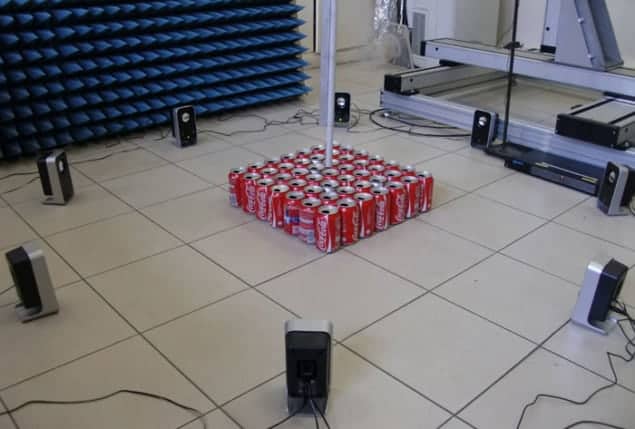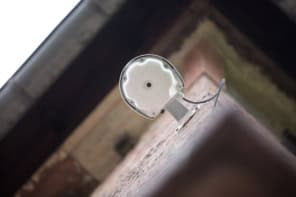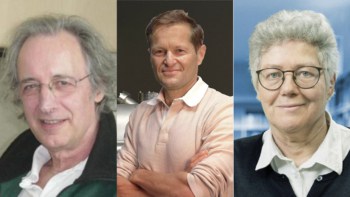
“Acoustic metamaterial” may sound exotic, but researchers in France have managed to assemble one from a few multipacks of cola cans. Arranged in a grid, the drinks cans act as a superlens for sound, focusing acoustic waves into much smaller regions than their metre-long wavelengths typically allow. The cans act as resonators, directing the volume of the sound to peak in a space just a few centimetres wide, and this heightened precision could improve acoustic-actuator systems.
Propagating light or sound waves diffract when they encounter an object, with the resulting interference preventing the waves from being focused to a spot smaller than about half their wavelength. However, the scattering process also involves evanescent waves, which prevent discontinuities in the electromagnetic field and fade away quickly – within half a wavelength of the reflecting object.
Superlenses pick up and amplify these evanescent waves and offer a way of beating the diffraction limit. Now, Geoffroy Lerosey, Fabrice Lemoult and Mathias Fink of the Institute Langevin in Paris have developed a system to build and control evanescent waves in order to tightly focus acoustic energy.
Collective resonance
Each can resonates at about 420 Hz, which is slightly below the standard concert tuning pitch of A above middle C. However, by assembling 49 cans into a seven-by-seven square, the cans resonate collectively rather than individually. By playing a single tone using different combinations of the eight speakers surrounding the array of cans, the researchers are able to make the cans resonate at frequencies of about 340–420 Hz. These resonances are the evanescent waves building up among the cans.
The different resonances produced different shapes in the pressure distribution across the array, measured with a microphone suspended above the cans. Once the researchers had recorded the 49 pressure distributions, or resonant modes, they were able to devise ways to layer the resonances so that these built up in some places and cancelled out in others.
The team managed this through time reversal, a method that owes much to Fink’s work since the early 1990s. The researchers choose a can that will host the focused sound and imagine that sound travelling from it to each of the speakers. The team then plays time-reversed versions of these hypothetical waves through the speakers, and the sound naturally builds on itself at the chosen can and cancels out elsewhere. “I can also choose to build a more complex wave field over the cans, focusing on three points at the same time,” says Lerosey.
Ghostly sounds
This technique concentrates the acoustic waves on a spot one-quarter the size of the diffraction limit. To focus the sound even tighter, the team needed to counteract the energy losses incurred as the waves pass through the cans. This is done by amplifying the frequencies that are lost, thus creating signals that build up and cancel out more precisely. These ghostly sounds, like a chime struck in the distance that makes a sheet of metal shake nearby, focus on spots not much bigger than the mouth of a can – about a 12th of the diffraction limit.
“I am especially impressed by their experimental set-up. It’s simple and neat,” says Jie Zhu of the University of California, Berkeley. “Yet, their experimentally demonstrated results are clear and straightforward.”
Nicholas Fang of the Massachusetts Institute of Technology in Cambridge calls the new approach for focusing sound “exciting”. He believes it could be applied to ultrasound frequencies by using smaller resonators. “Such an effect could be useful for applications such as cell sorting in biomedical fields and particle removal in ultrasound cleaning, as well as other interesting actuators,” he explains.
Moving with sound
Acoustic actuators harness sound waves to physically move objects, and Lerosey points out that the acoustic field generated by the cans is not only more precise than an ordinarily focused field, it is also stronger. He also suggests that the technique could be extended to focusing waves in elastic materials. But on a fundamental level, Lerosey says this new strategy “gives you the possibility to manipulate sound in new ways that have never been achieved before”.
This research will be published in Physical Review Letters.



